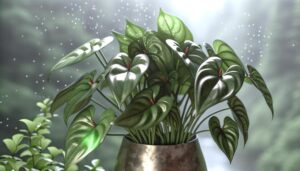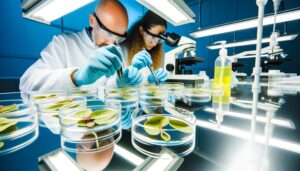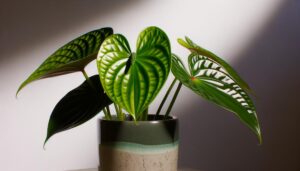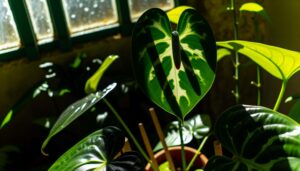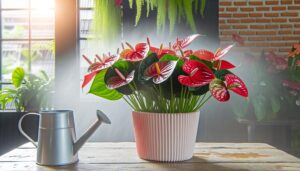Top 5 Tips for Anthurium Care in Hawaii
To care for Anthuriums in Hawaii, keep them in bright, indirect sunlight. Avoid direct sun to prevent leaf damage.
Water until excess drains, letting the top inch of soil dry first. Use well-draining soil with organic matter and apply balanced, slow-release fertilizer every 6-8 weeks.
Maintain temperatures of 70-85°F and humidity levels around 70-80%. Inspect for pests like aphids and treat with insecticidal soap or neem oil promptly.
Ensuring proper drainage and sterilizing pruning tools will help prevent diseases. With these tips, your Anthuriums will thrive, and there's more to discover for perfect care.
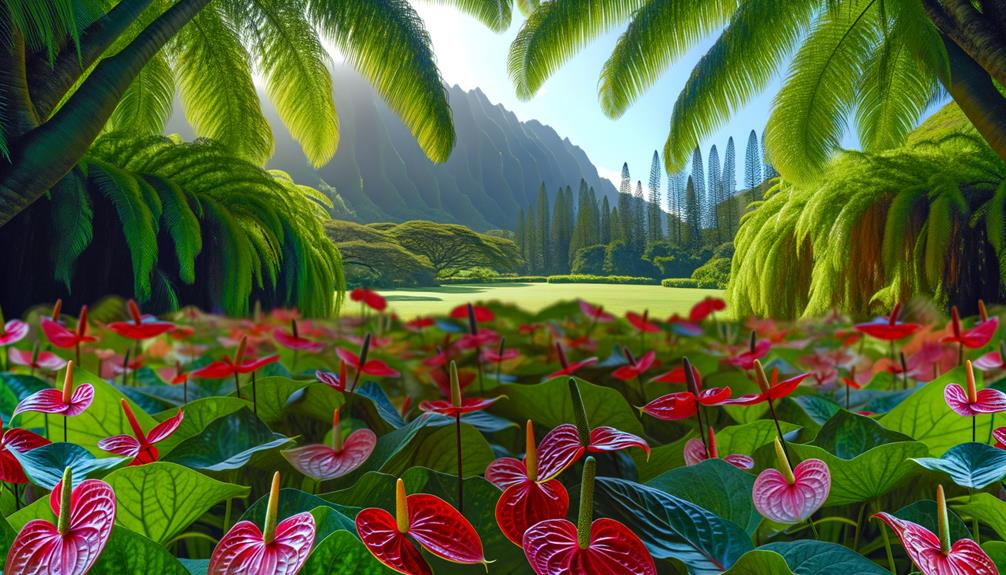
Key Takeaways
- Position Anthuriums in bright, indirect sunlight to prevent leaf damage.
- Allow the top inch of soil to dry before watering to avoid root rot.
- Use a well-draining potting mix rich in organic matter.
- Maintain temperatures between 70-85°F and high humidity around 70-80%.
- Regularly inspect and treat for pests with insecticidal soap or neem oil.
Optimal Lighting Conditions
When it comes to ideal lighting conditions for Anthurium plants in Hawaii, you'll need to make sure they receive bright, indirect sunlight to thrive. Direct sunlight can scorch their leaves, causing irreversible damage. Best placement would be near a north or east-facing window where they can enjoy ample light without harsh rays.
Alternatively, if you're growing them outdoors, position them under a tree canopy or use a shade cloth to filter the sunlight. Regularly rotate the plant to promote even growth and avoid leaning.
If natural light is insufficient, consider using fluorescent grow lights set on a timer for about 12-14 hours a day. This ensures the plant gets consistent light, promoting healthy growth and vibrant blooms.
Proper Watering Techniques
To ensure your Anthurium thrives, mastering the art of proper watering techniques is crucial.
First, let the top inch of soil dry out between waterings. Overwatering can lead to root rot, while underwatering results in wilting.
Use a well-draining pot to prevent water from accumulating at the roots. Water your Anthurium until you observe excess draining from the bottom, ensuring the roots receive sufficient moisture.
In Hawaii's moist climate, aim to water early in the day to allow foliage to dry, reducing the risk of fungi. Always use water at room temperature to prevent shocking the plant.
Soil and Fertilizer Needs
Achieving lively Anthurium growth also depends on choosing the right soil mix and providing balanced fertilization.
Use a well-draining, coarse potting mix with organic matter like peat moss, perlite, and pine bark to mimic their native tropical habitat. Avoid heavy, water-retentive soils that can cause root rot.
For fertilization, apply a balanced, slow-release fertilizer every 6-8 weeks. Look for a formula with equal parts nitrogen, phosphorus, and potassium (e.g., 20-20-20).
During the growing season, supplement with a liquid fertilizer diluted to half-strength every 4-6 weeks to promote strong foliage and lively blooms.
Monitoring pH levels, ideally between 5.5 and 6.5, ensures nutrient availability and best plant health.
Temperature and Humidity
Maintaining ideal temperature and humidity levels is important for thriving Anthurium plants, particularly in Hawaii's tropical climate. Aim for temperatures between 70-85°F during the day and not below 60°F at night. Anthuriums are sensitive to cold drafts and temperature fluctuations, so keep them away from air conditioners and open windows.
Humidity should be consistently high, ideally between 70-80%. You can achieve this by using a humidifier or placing a pebble tray with water near the plants. Misting the leaves regularly also helps, but avoid over-wetting the soil to prevent root rot.
Proper air circulation is essential, so maintain good ventilation without exposing the plants to direct wind. These conditions will help your Anthuriums flourish.
Pest and Disease Control
While maintaining ideal temperature and humidity, you also need to be vigilant about pest and disease control to keep your Anthuriums healthy in Hawaii's unique environment.
Regularly inspect your plants for common pests like aphids, mealybugs, and spider mites. Use insecticidal soap or neem oil to treat infestations promptly.
Fungal diseases such as root rot and leaf blight can be prevented by ensuring proper drainage and avoiding waterlogged soil. Sterilize pruning tools to prevent bacterial infections. Incorporate a balanced fertilizer to boost plant immunity.
If you notice yellowing leaves or stunted growth, it might indicate a pest or disease issue. Early detection and immediate action are essential for maintaining the health and vibrancy of your Anthuriums.
Conclusion
To wrap it up, excelling in anthurium care in Hawaii involves ideal lighting, precise watering, suitable soil, and fertilizers, and managing temperature and humidity.
Did you know that overwatering is the primary reason for anthurium plant failure, responsible for nearly 70% of cases?
By following these recommendations, you'll greatly improve your anthurium's health and longevity.
With careful attention, your anthuriums will thrive, adding colorful beauty to your Hawaiian garden.

